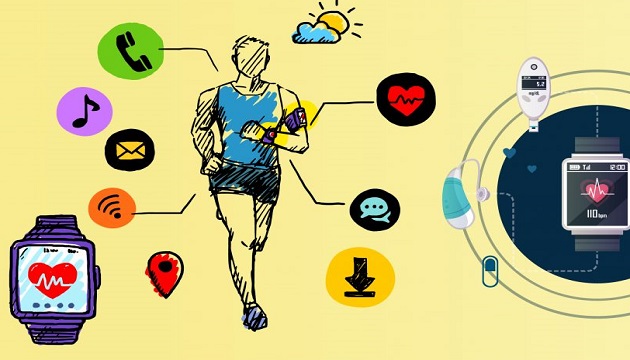An increasing demand from consumers to assess their health at any moment has driven the wearable industry’s massive expansion. Fit Bits, Garmin Forerunners and Apple Watches track personal information such as heart rate, step count and sleep, providing consumers with data in real-time.
The demand for wearables isn’t isolated to consumers. Rather, the technology’s transformative data usage has drawn the interest of businesses. Companies are supplying employees with wearables to decrease healthcare costs and provide employees with personalized health information to support health consciousness.
As Technologies Advance, Fitness Trackers and Health Monitors Maintain Popularity, smart watches and fitness trackers have dominated the consumer wearable market and will continue to maintain a dominance despite an increasing diversification of wearable technologies. In 2009, Fit bit debuted as the first wearable device. The earliest version of the product featured a single button that cycled through the display to analyse a consumer’s progress toward the 10,000 step goal.
Influence on market
International Data Corporation found that wristbands will experience a negative growth rate in the coming years, smart watches will continue to grow. By 2023, watches will account for nearly 50 percent of the entire wearables market. Overall, the proliferation of various wearable technologies drives the market’s growth. New products and vendors—from Fossil to Louis Vuitton— are entering the market rapidly.
The global wearables market will swell to $54 billion by 2023. More than half of people interested in buying wearable technology were interested in the devices to track physical activity and monitor personal health. Wearables not only count steps and active minutes but also track sleep and monitor heart-rates 24/7. Most devices have improved their battery lives, increasing their viability and desirability as there are fewer reasons for consumers to take them off.
Current wearables curate feedback to consumers’ individual habits. Rather than a set 10,000-step goal, devices now notify users when it senses they’re moving less than usual. With product proliferation and technical improvements, wellness-related wearable technologies are expected to sustain growth as consumers continue to pursue healthier lifestyles.
Prominence in the healthcare sector
Wearables Appeal to Businesses by Saving Health Insurance Costs. Businesses can decrease health care costs through personalizing insurance plans by providing employees with wearables. When a plan is catered to an individual, there are fewer unnecessary costs. Wearables are no longer just counting steps, but also monitoring users’ blood pressures.
Wearables enable doctors to track patients remotely, reducing transport and readmission costs. Further, businesses can implement interactive healthcare policies to tailor their healthcare offerings. This can reduce the costs associated with traditional policies that provide blanket coverage. Wearables provide new options for employee healthcare that incentivize healthy habits and reduce costs.
Omron Healthcare debuted the first wearable blood pressure monitor called the Heart Guide in 2019. Designed to look like an average smart watch, the device acts as an oscillometric blood pressure monitor. The wearable measures a user’s blood pressure and daily activity. The device can store up to 100 readings in its memory. At that point, users can transfer the readings to the corresponding mobile application: Heart Advisor. Users can store, track and share data for review, comparison and treatment optimization.
One of the largest North American life insurers—John Hancock—will stop selling traditional life insurance policies. Instead, the provider will offer interactive policies that track fitness and health data through wearables. Policyholders who hit exercise targets will have access to premium discounts. Clients will also receive gift cards for workouts and healthy food purchases logged in the app. On the other hand, customers with high-risk habits such as smoking will pay higher premiums.
Healthcare Providers Leverage Wearable Medical Technology to Improve Medical Treatment by tracking data, wearables enable businesses in the healthcare industry to apply personalized modifications to treatment plans. This allows healthcare providers to make more informed decisions and patients to receive better treatment.
Future apprehensions
Wearables can also encourage patient responsibility. Custom software solutions have grown to support patients’ adherence to a care routine. For example, a smart necklace has been proposed to detect user ingestion of a pill based on skin movement associated with swallowing. The devices can also alert users when it’s time to take medication, track the times when it’s taken and notify doctors when a regimen isn’t followed. Medical professionals can adjust care options and predict potential health problems to prescribe cost-saving preventative measures rather than costly treatment options
Wearables provide doctors with more data regarding a user’s health. Rather than relying on patients to report symptoms, which can be incomplete or delayed, a wearable collects data indiscriminately and reports in real-time. Unlike users, wearables don’t forget to track symptoms as a result of their biosensors. The technology provides providers with an extensive history to support more informed analysis and optimized care decisions.
As wearables provide personalized health information, businesses can leverage their popularity among consumers to improve employees’ health and healthcare. The greater and more accurate information wearables track offers opportunities for companies to personalize health care plans. Personalized plans are more cost-effective for consumers and businesses.








